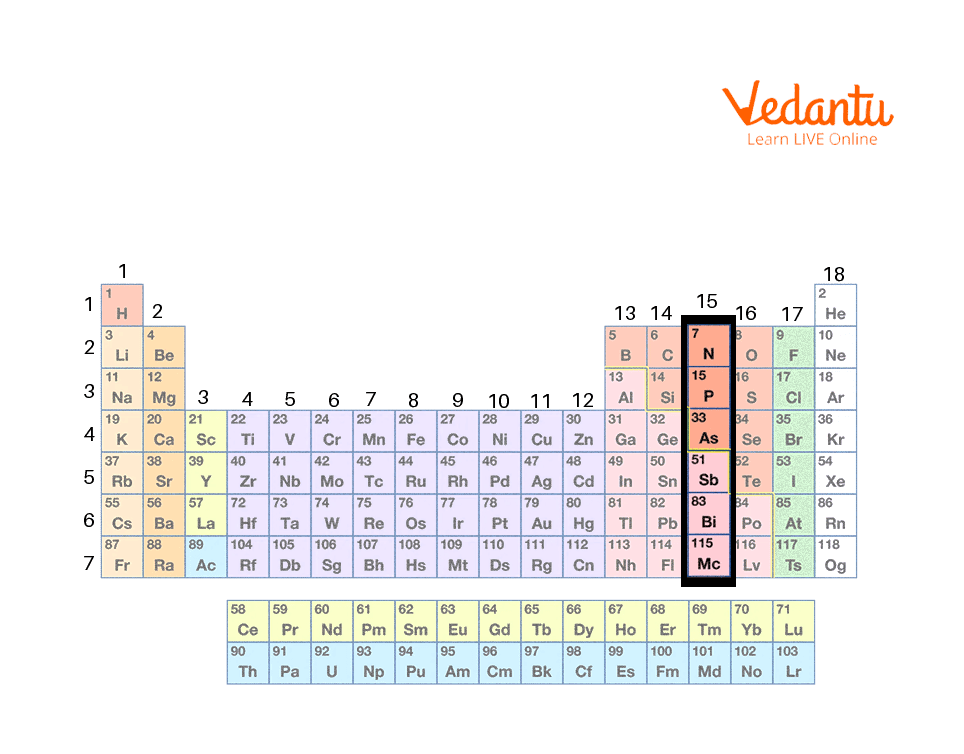




Step-by-Step Guide to Write Antimony’s Electron Configuration
Group 15 elements contain nitrogen (N), Phosphorus (P), Arsenic (As), Antimony (Sb), and Bismuth (Bi). All group 15 elements have the electron configuration ns2np3 in their outer shell, where n is the principal quantum number. The N family is found in the p-block in group 15.
Valence electrons are the electrons in an atom's outermost shell or energy level. In other words, a valence electron may be a negatively charged particle placed in the outermost shell of an atom that can be transferred to or shared with another atom.

Group 15 Elements in The Periodic Table
What is Electronic Configuration?
Electronic configuration, also referred to as electronic structure or electron configuration, is the arrangement of electrons in orbitals around an atomic nucleus. The symbols used for writing the electron configuration begin with the shell number (n) followed by the type of orbital. Eventually, the superscript indicates how many electrons are in the orbital.
Rules to Write the Electronic Configuration
Rules to determine the electronic configuration for any element are listed below:
Pauli Exclusion Principle
Hund’s Rule
The filling of electrons into the orbitals of different atoms takes place according to the Aufbau principle which is based on Pauli’s exclusion principle, Hund’s rule of maximum multiplicity, and the relative energies of the orbitals.
Electronic Configuration of Group 15 Elements
Nitrogen: (Atomic no. 7)
The electronic configuration of N is 1s22s22p3. It is a non-metallic component and has no taste and no colour. When compared with the rest of group fifteen, N has the highest electronegativity which makes it the most nonmetallic of the group. The common oxidation states of (atomic number 7) N are +5, +3, and -3.
Phosphorus : (Atomic no. 15)
The electron configuration of P is [Ne]3s23p3. The most common oxidation state of phosphorus is -3. Phosphorus is the eleventh most abundant component, making up 0.11% of the Earth's crust. The main source of phosphorus compounds is phosphorus rocks.

Group 15 Element’s Electron Configuration
Arsenic : (Atomic no. 33)
The electron configuration of As is [Ar]3d104s24p3. Arsenic may be an extremely toxic metalloid. Because it's a nonmetal, arsenic contains a high density, moderate thermal conduction, and a restricted ability to conduct electricity. The oxidation states of arsenic are +5, +3, +2, +1, and -3. Compounds of arsenic are utilised in pesticides, weed killers, and alloys.
Antimony : (Atomic no. 51)
The electron configuration of Antimony (Sb) is [Kr]4d105s25p3.
Bismuth : (Atomic no. 83)
The electron configuration of Bi is [Xe]4f145d106s26p3.
Valence Electrons in Antimony
Antimony (Sb) has an atomic number of 51. The valence electrons are referred to as the free electrons that are available at the last orbital. In Sb, the total electron shells are five. The electronic configuration of Sb is 2, 8, 18, 18, and 5. Thus, the Antimony valence electrons are five.
Electron configuration of Sb is 1s2 2s2 2p6 3s2 3p6 4s2 3d10 4p6 4d105s2 5p3. In the above configuration, the last orbital is five. Therefore, the valency of Sb or Antimony valency is 5. Antimony is a non-metal. The oxidation states of Sb are +3, -3, and +5. Sb exhibits allotropy; the most stable allotrope is the metallic form, which is analogous in properties to arsenic:
High density.
Moderate thermal conductivity.
Limited ability to conduct electricity.
The oxide of Sb is Sb (III) oxide which is amphoteric, which means it will act as an acid and a base.
Noble Gas Electron Configuration for Nitrogen
The noble gas configuration of nitrogen is [He]2s22p3. Nitrogen has atomic number seven on the periodic table. This implies that every N atom has seven protons in its nucleus. A neutral N atom additionally has seven electrons. The noble gas electron configuration contains the symbol for the noble gas within the previous period and also the remaining configuration is written out. N is in the 2nd period of the periodic table, therefore the previous noble gas is He.
Interesting Facts
Antimony is obtained mainly from its sulphide ores, and it evapourates at low temperatures.
Along with arsenic, Sb is often utilised in alloys.
Arsenic and Sb are used to manufacture semiconductor materials like GaAs, GaSb, and InSb in electronic devices.
Important Questions
1. What are the atomic properties of group 15 elements?
Ans:
Atomic and ionic radii: The atomic and ionic radii of group fifteen components are smaller than the atomic radii of the corresponding group fourteen components.
Ionisation enthalpies: On going down the group, the ionisation enthalpies decrease.
Electronegativity values: On going down the group, the electronegativity value decreases.
The elements of group fifteen are less metallic. However, on going down the group, the metallic character will increase from N to Bi. For example, the N and P are non-metallic, As and Sb are partially non-metallic whereas Bi is a metal.
Conclusion
The elements of group fifteen in the periodic table are called the nitrogen family. The atoms of group fifteen have 5 electrons within the outermost shell, two in s, and three in the p subshell. The final electronic configuration of this group could also be expressed as ns2 np3. The valency of Sb and the noble gas configuration of N and another group fifteen components are often determined.
FAQs on Electronic Configuration of Antimony Explained
1. What is the complete electronic configuration of Antimony (Sb)?
Antimony has an atomic number of 51. Its full electronic configuration, written in order of energy levels, is 1s² 2s² 2p⁶ 3s² 3p⁶ 4s² 3d¹⁰ 4p⁶ 5s² 4d¹⁰ 5p³. This shows how its 51 electrons are distributed across different orbitals.
2. How can I write the shorthand or noble gas configuration for Antimony?
To write the shorthand configuration, we use the symbol of the preceding noble gas. For Antimony, the previous noble gas is Krypton (Kr). The shorthand configuration is [Kr] 4d¹⁰ 5s² 5p³. This notation simplifies the full configuration by representing the stable, filled inner shells with the noble gas symbol.
3. How many valence electrons does an Antimony atom have?
An Antimony atom has 5 valence electrons. These are the electrons in its outermost shell (n=5), which are located in the 5s and 5p orbitals (5s² 5p³). These electrons are responsible for Antimony's chemical bonding and properties.
4. How does Antimony's electronic configuration determine its position in the periodic table?
The electronic configuration of Antimony tells us exactly where to find it:
- Period: The highest principal energy level is n=5 (from 5s² 5p³), so Antimony is in Period 5.
- Block: The last electron enters the p-orbital, placing it in the p-block.
- Group: For p-block elements, the group number is 10 + (number of valence electrons). For Antimony, this is 10 + 5 = Group 15.
5. Why are +3 and +5 the most common oxidation states for Antimony?
These oxidation states are a direct result of its valence electron configuration (5s² 5p³).
- The +3 oxidation state is achieved when Antimony loses the three electrons from its outermost 5p orbital.
- The +5 oxidation state occurs when it loses all five of its valence electrons from both the 5s and 5p orbitals.
6. How does the electronic configuration explain why Antimony is a metalloid?
Antimony's status as a metalloid is explained by its five valence electrons. It is energetically difficult for it to lose all five electrons to behave like a true metal, and it is also difficult to gain three electrons to behave like a true non-metal. This intermediate nature, where it can share or lose electrons under different conditions, gives it properties of both metals and non-metals, defining it as a metalloid.
7. What is the 'inert pair effect' and how does it relate to Antimony?
The inert pair effect is the tendency of the two electrons in the outermost s-orbital (the 5s² electrons in Antimony) to remain unshared or not participate in bonding. In Antimony, this effect is present but not as strong as in heavier elements like Bismuth. It explains why the +3 oxidation state (where only p-electrons are lost) is very stable for Antimony, sometimes even more so than the +5 state.
8. How many protons and electrons are in a neutral atom of Antimony?
For any neutral atom, the number of protons and electrons is equal to its atomic number. Since Antimony's atomic number (Z) is 51, a neutral Antimony atom contains 51 protons and 51 electrons.
























